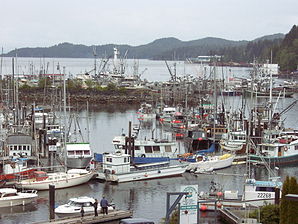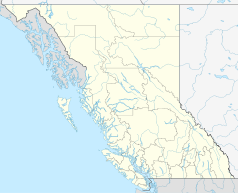Port Hardy
| Port Hardy | ||
|---|---|---|
 Port Hardy Harbor |
||
| Motto : Living the adventure | ||
| Location in British Columbia | ||
|
|
||
| State : |
|
|
| Province : | British Columbia | |
| Regional District : | Mount Waddington | |
| Coordinates : | 50 ° 43 ′ N , 127 ° 30 ′ W | |
| Area : | 38.73 km² | |
| Residents : | 4132 (as of 2016) | |
| Population density : | 106.7 inhabitants / km² | |
| Time zone : | Pacific Time ( UTC − 8 ) | |
| Postal code : | V0N | |
| Foundation : | 1966 (incorporated) | |
| Mayor : | Bev Parnham | |
Port Hardy is a small town on the north of Vancouver Island in the Canadian province of British Columbia .
The community is near the terminus of Highway 19 from the Duke Point Ferry Terminal in Nanaimo to the Bear Cove Ferry Terminal . As the northernmost town on the island, Port Hardy forms the gateway to Cape Scott Provincial Park about 50 km further west, which is partially only accessible via gravel roads. The same goes for Brooks Peninsula .
The name of the place goes back to Vice Admiral Sir Thomas Masterman Hardy , the captain of the HMS Victory .
history
The local museum has three focal points in line with regional history. The most important is the history of the First Nations , which goes back around 8,000 years, then the post of the Hudson's Bay Company (HBC), and finally the history of the so-called pioneers. To present their history, an association of nine museums has been formed, which present the history and culture of the northern tip of the island.
In the vicinity of the place the oldest finds of the settlement of Vancouver Island were made. The site is a bay, the Bear Cove , whose artifacts go back to about 6000 BC. Are datable. Between 3000 BC and AD 500, a culture characterized by obsidian blades prevailed . The subsequent third period is less of a hunter-gatherer culture than a maritime culture, which is characterized by canoes and other prey, namely seals and salmon .
In 1792, Captain James Johnstone sailed past Quatse Bay. The Johnstone Strait east of Port Hardy was named after him.
When the HBC had Fort Rupert built, the surrounding tribes - armed with rifles through the fur trade in Europeans - had become successful traders and slave hunters who extended their raids as far as Washington . But the Europeans also brought in diseases such as smallpox , which first struck the coastal Salish along the coast ( from 1775 ), then the Nuu-chah-nulth tribes living on the west coast of Vancouver Island ( especially 1862 ), and finally the Kwakwaka'wakw tribes around Port Hardy.
In 1860, when Captain Richards took him north on his exploration , named Hardy Bay after Lieutenant Thomas Masterman Hardy, who had played a role in the Napoleonic Wars .
The first settlers came to the place only in 1904 and called it Port Hardy, but in 1925 the place was moved to the west side of the bay. A certain influence of this group, which concentrated around Holberg , became noticeable through Danish immigration . A wandering sawmill was built there in 1940, which led to complete deforestation in some areas .
The Royal Canadian Air Force maintained a radar station near the city from the 1950s to 1991 .
The population of the municipality grew over the years, so that on April 5, 1966, the municipality was granted municipal self-government ( incorporated as a District Municipality ).
Demographics
The census in 2016 showed a population of 4,132 inhabitants for the municipality, after the census in 2011 showed a population of 4,008 inhabitants for the municipality. The population has thus increased by 3.1% compared to the last census in 2011, while the population in the province of British Columbia increased by 5.6% at the same time. In the census period 2006 to 2011, the population had increased by 186 inhabitants (4.1%) and was thus below the provincial average with an increase of 7.0%. With this population increase, it turned the population loss the municipality had suffered compared to the 2001 census. In the 2001-2006 census period, the population had decreased by 16.4%, while in the province the population had increased by 5.3%.
Infrastructure
Despite its small population and the surrounding wilderness, Port Hardy has a small town character. It also offers enough services to cater for the additional tourists in summer. There is a visitor and a larger shopping center and connected supermarkets, three 24-hour petrol stations, clothing and art shops, a sports hall, car dealerships, bank branches, a library, churches, bars and restaurants and dozens of smaller shops. A hospital, a fire station and ambulance as well as a police station make up the public service.
Other public facilities are the clock tower, the pier and the Rotary Park. There is also a skate park near the arena and the swimming pool.
climate
In winter the average temperature is 0.5 ° C and the snow depth is 63 cm. In summer, however, the mean rises to 17.7 ° C. Rainfalls are sometimes heavy and add up to an annual mean of 1870 mm.
Flora and fauna
Deer , black bears , bald eagles , ground squirrels and a wide variety of small animals and birds can be seen in the Port Hardy area, and even in the city itself . This has to do with the fact that the animals have been and are being deprived of their habitat through road construction, but above all through ruthless deforestation. Sightings are not uncommon, especially along the Quatse Loop nature trail or at Storey's Beach. Also, humpback whales can be seen from the bay at Rotary Park from. Consequently, animal observations are offered by boat, on foot or by kayak, as well as fishing trips and camping sites in the high season. The tidal range of Queen Charlotte Strait is usually between 2 and 5 meters. The resulting intertidal zone is rich in marine life. At low tide there is a chance to see mussel beds and other marine life on the beach.
But that cannot hide the fact that little remains of the original landscape. Only the parks still offer remnants of the temperate rainforests .
tourism
The (tourist) motto of the municipality is: Living the adventure . The entrance sign of the place is designed accordingly. Since a large part of the population lives from tourism today, there are now many motels and bed & breakfasts as well as a youth hostel . Nevertheless, many accommodations are fully booked in the high season, because this is the time when most visitors come to take one of the ferries operated by BC Ferries to cruise the famous Inside Passage to Prince Rupert and on to Alaska . The approximately 16-hour drive to Prince Rupert is known for the almost untouched landscape and the whales and dolphins that can be seen there.
The regional handicrafts are clearly shaped by indigenous artists. Galleries on Market Street offer their carvings. This is even more true of the artists at Fort Rupert. Immediately around the place who live First Nations of Quatsino , the Gwa'Sala-'Nakwaxda'xw First Nation and the Kwakiutl , and short distance to Fort Rupert.
Filomi Days, abbreviated as Fi-Lo-Mi, stands for Fishing-Logging-Mining and is an event that usually takes place on the 3rd weekend in July. At this festival, competitions are mainly held in the eponymous disciplines.
Web links
Individual evidence
- ↑ Walbran, John T. British Columbia Coast Names, 1592-1906: their origin and history. Ottawa, 1909
- ^ Origin Notes and History. Port Hardy. GeoBC , accessed on August 21, 2017 .
- ↑ Port Hardy Community Profile. Census 2016. In: Statistics Canada . January 23, 2017, accessed on August 22, 2017 .
- ↑ Statistics Canada (2011 Census). Port Hardy District Municipality Profile
- ↑ Statistics Canada (2006 Census). 2006 Community Profiles - Port Hardy
- ↑ Port Hardy (# 8408) Tidal Prediction. Fisheries and Oceans Canada , accessed April 29, 2016 .
- ↑ http://www.seevirtual360.com/themes/2/..%5C..%5Cphotos%5Ctours%5Cthumbnails%5C30312.jpg
